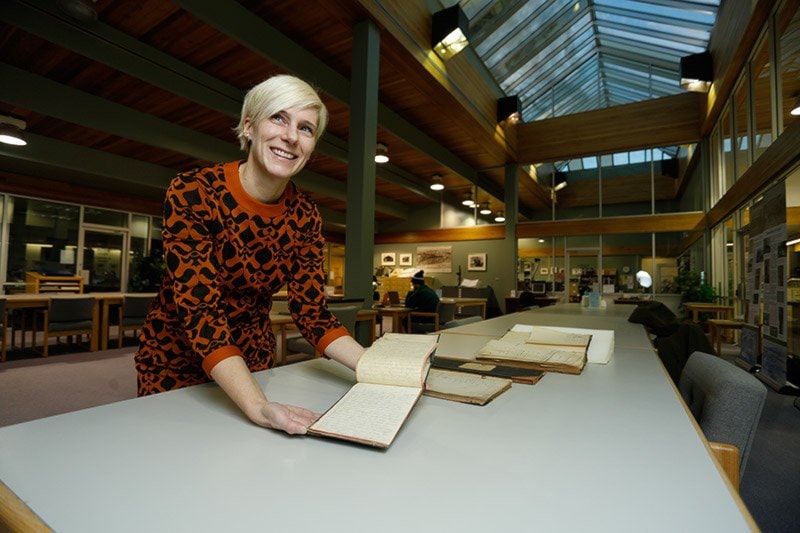A journal recounting the travels of one of the Yukon’s earliest settlers has been discovered decades after it was thought to have been lost in a fire.
The recollections of Leroy Napoleon “Jack” McQuesten had actually been kept safe under the staircase of a house in Dawson City.
McQuesten, who some nicknamed the “Father of the Yukon,” was in the territory before the rush of prospectors. He established multiple trading posts in the late 1800s that would be used by those hoping to strike it rich.
He was a founding member of the Yukon Order of Pioneers (YOOP).
As the story goes, sometime in the late 1800s or early 1900s the order’s historian asked early settlers to write down their recollections of arriving in the territory.
McQuesten responded with 60 pages covering 1871 to 1885 when he travelled from northern Alberta to what would become the Yukon and his early years working in the territory. The book is small, the paper thin and the memories are scribbled in graphite.
The book was kept by YOOP in Dawson for years. In 1952 it was transcribed and first published as a novel.
When the YOOP offices burned to the ground in 1967 the writing was presumed lost.
So it was hardly something that archivist Jenn Roberts was thinking about when Ralph Troberg came into the Yukon Archives late last year with a mishmash of things collected by his father.
Troberg’s father - also named Ralph - was once a grand historian for the YOOP, Roberts said.
“His father was, in the ’50s, collecting records of historical value to the YOOP but also to Dawson generally, and shoving them under his stairs.”
The items were later moved to the younger Troberg’s crawlspace before ending up on Roberts’ desk late last year.
“He knew his dad did this, he knew his dad had old stuff under the stairs, but he basically had never particularly taken an interest. He didn’t really know what was there.”
When she first saw the book, Roberts thought that it may have been written by McQuesten’s daughter, Mary. McQuesten’s initials “L.N.,” written on the first page, looked like an “M,” she said.
“It was a non-historian’s assumption.”
There were other stars that had to align for the journal’s true identity to be revealed.
Not all items donated to the archives get a detailed line-by-line transcription, the way the McQuesten journal did.
But when it came through the archives’ doors Pam Brown happened to be working there. Brown was part of the Yukon College Targeted Initiative for Older Workers, a program that helps older workers upgrade their skills to find work.
Brown agreed to transcribe a few pages. After about 40 hours of work, she’d finished the whole book.
“I was blown away by the concept of being the only white man for 150 miles and just floating down the river and setting up a trading post,” Brown said. “… as you’re moving up to get here, building a cabin every fall and using chunks of ice that you’ve cut from the lakes for windows.”
It was clear early into the transcription that this wasn’t a journal written by McQuesten’s daughter. But it wasn’t until Brown’s work was compared side-by-side with the published versions of McQuesten’s journal that staff realized they had McQuesten’s original writing.
Roberts read in one of the books that the original journal had been lost in a fire. “Then I was like, ‘Oh, my God, look what we have!’” she said.
“I know that sounds ridiculous but that’s pretty much what I did.”
Being able to look at the original, as opposed to relying on a published copy transcribed by someone else, is a unique experience, Roberts said.
“It’s that connection to the first. It’s the authentic nature of the record, which is why it’s so important. There are no others. You can have multiple copies of books, there is only one of these.”
Having the original, before it is formatted or transcribed, means “it’s as raw and as neutral as something can be,” she said.
Along with McQuesten’s journal, Troberg’s boxes were a trove of other historical finds all related to Dawson or the YOOP.
The first city council minute book from 1904 and the 1901 tax assessments, including drawings of who lived where, were all kept by Troberg for posterity.
Yukoners can come to the Yukon Archives and see all the documents, including the journal , Roberts said.
“If there’s one thing I could shout from the rooftop it’s this idea that archives are supposed to be accessible and used by the people.”
Contact Ashley Joannou at ashleyj@yukon-news.com
